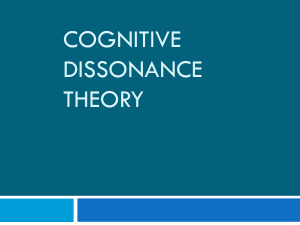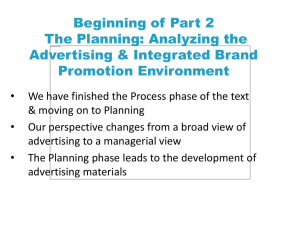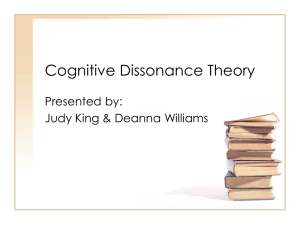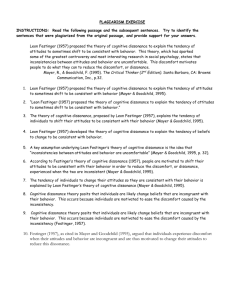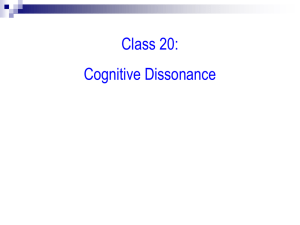doc
advertisement
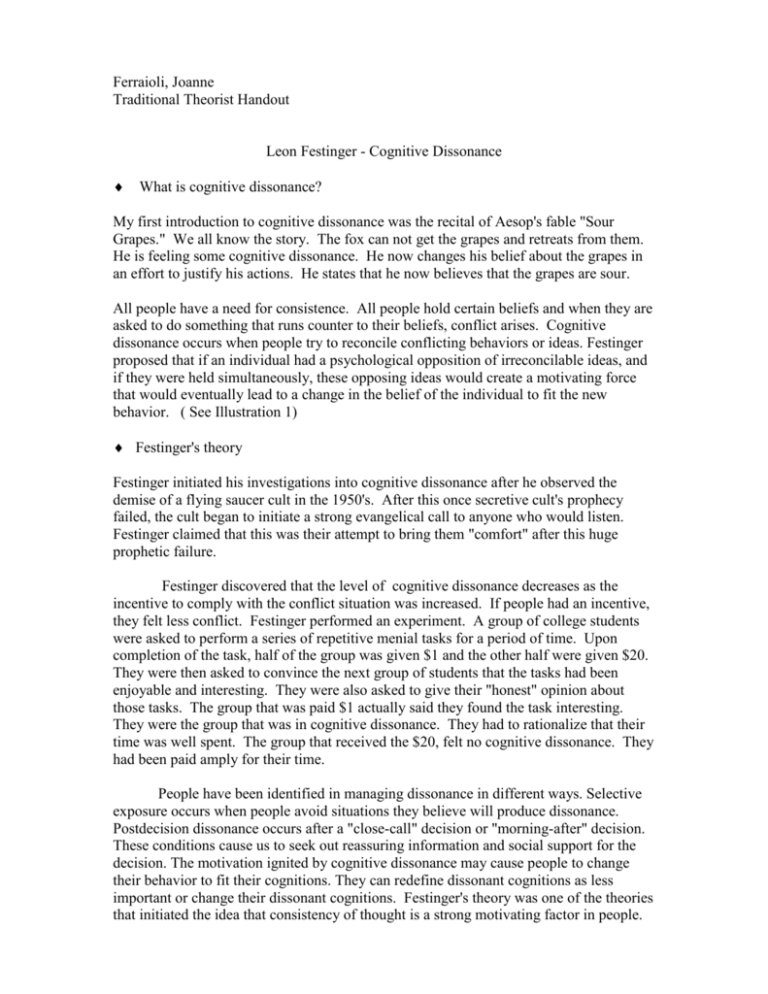
Ferraioli, Joanne Traditional Theorist Handout Leon Festinger - Cognitive Dissonance What is cognitive dissonance? My first introduction to cognitive dissonance was the recital of Aesop's fable "Sour Grapes." We all know the story. The fox can not get the grapes and retreats from them. He is feeling some cognitive dissonance. He now changes his belief about the grapes in an effort to justify his actions. He states that he now believes that the grapes are sour. All people have a need for consistence. All people hold certain beliefs and when they are asked to do something that runs counter to their beliefs, conflict arises. Cognitive dissonance occurs when people try to reconcile conflicting behaviors or ideas. Festinger proposed that if an individual had a psychological opposition of irreconcilable ideas, and if they were held simultaneously, these opposing ideas would create a motivating force that would eventually lead to a change in the belief of the individual to fit the new behavior. ( See Illustration 1) Festinger's theory Festinger initiated his investigations into cognitive dissonance after he observed the demise of a flying saucer cult in the 1950's. After this once secretive cult's prophecy failed, the cult began to initiate a strong evangelical call to anyone who would listen. Festinger claimed that this was their attempt to bring them "comfort" after this huge prophetic failure. Festinger discovered that the level of cognitive dissonance decreases as the incentive to comply with the conflict situation was increased. If people had an incentive, they felt less conflict. Festinger performed an experiment. A group of college students were asked to perform a series of repetitive menial tasks for a period of time. Upon completion of the task, half of the group was given $1 and the other half were given $20. They were then asked to convince the next group of students that the tasks had been enjoyable and interesting. They were also asked to give their "honest" opinion about those tasks. The group that was paid $1 actually said they found the task interesting. They were the group that was in cognitive dissonance. They had to rationalize that their time was well spent. The group that received the $20, felt no cognitive dissonance. They had been paid amply for their time. People have been identified in managing dissonance in different ways. Selective exposure occurs when people avoid situations they believe will produce dissonance. Postdecision dissonance occurs after a "close-call" decision or "morning-after" decision. These conditions cause us to seek out reassuring information and social support for the decision. The motivation ignited by cognitive dissonance may cause people to change their behavior to fit their cognitions. They can redefine dissonant cognitions as less important or change their dissonant cognitions. Festinger's theory was one of the theories that initiated the idea that consistency of thought is a strong motivating factor in people. Nature of the topics: Dimensions Breadth of the Dimensions: This theory is definitely affective. Reigeluth states that "attitudes are the crux of all the affective dimensions of development"(page 496). This theory is entirely based upon the construction and reconstruction of beliefs or attitudes based on internal motivational factors. It was hard to localize the dimension. I believe that this is would center its' dimension with motivational affective development, but would also be strongly associated with emotional and moral. Moral dilemmas and emotional conflicts great causing of cognitive dissonance and therefore great contributors to the motivational factors that would change behaviors. As previously stated , this theory is very comprehensive. Nature of the Topics: The topics primarily associated with cognitive dissonance are primarily affective. Integration of the Curriculum: Control of Learning: Duration of Curriculum: Grouping of Learning: Personal Focus of Curriculum: Cognitive dissonance is very isolated curriculum. It has absolutely no attachment to regular school subjects. The student has absolute control over the nature of the learning process. The whole idea of cognitive dissonance is that the motivation occurs as a result of internal dissonance. This dissonance initiates changes in beliefs or ideas in the student. Although the motivation that occurs as a result of cognitive dissonance may be on ongoing process through the year, each problem or decision that may initiate the mental condition is a one time shot. This is definitely an individual learning process. Although each student develops their individual beliefs to relieve their cognitive dissonance, we can categorize this theory as intra- and interpersonal. Sometimes the student will change beliefs in order to create a stronger interpersonal relationship. Instructional Methods: The instructional methods are indirect. They are not classroom activities, but the student does strongly hope that they have so changes in social support. Orientation of the Topic:These theory is both problem and opportunity based. Cognitive dissonance may occur if a student has to deal with a problem that goes against their belief system or the dissonanace may occur if a social problem occurs. Similar Theories : Balance Theory: Heider : People want to be in a balanced state. It measures the balance that exists between people, an opponent and the target of their opinion or idea. This measure is indicated with a plus or minus sign. Balance exists when one of certain conditions occur: If the principal and the opponent both have similar feelings toward the target or if the principal and the opponent disagree about their opinion or idea and they also are disagreeable towards each other. ( See illustration #2) People who are liked can pressure others to conform to their viewpoints because others will feel a need to agree with them because they are liked. We see this daily when "name-dropping" occurs. According to this theory, people will change their attitudes or relationships with others or convince others to change in and effort to bring balance back to their "emotional" state. Although very similar to Cognitive Dissonance, it is not concerned with the reasons behind these changes. Congruity Theory: Osgood, C., & Tannenbaum, P. - Building on the balance theory, this theory models how to predict the direction that changes will occur. This theory states that if there is a positive attitude toward a person/source and a negative attitude toward another source, we will more away from the positive attitude but toward the negative attitude in an effort to achieve balance. Unlike Festinger's theory, it does not take into account the reasons that people change attitudes or ideas. General & Specific Applications: You would use this theory when trying to explain behavior or attitude changes when working with students who are finding a particular topic difficult. Students may change their perception about the necessity of a training program or content if it continues to be outside their zone of proximal development. It is important not to maintain a balanced approach when working with students. The introduction and methodology of teaching can be the backbone of success for a program. If you are teaching with terminology that students do not understand, or continue to present material well above their existing level of comprehension, students will not be able to grasp the material. In order for them to restore their harmonic existence, some students will brush off the topic as that which they "don't really need anyway." This may be avoided by teaching to students in their comfort zone. Cognitive Dissonance Illustration 1 Balance Theory Illustration # 2 References Festinger, Leon. A Theory of Cognitive Dissonance. Evanston, IL:Ros, Peterson Carlsmith,James M. and Festinger, Leon.(1959) Congitive Consequences of Forced Compliance. Journal of Abnormal and Social Psychology, 58,203 - 210. Heider, Fritz. 1958. The Psychology of Interpersonal Relations. NY: Wiley. Chapter 7: Sentiment pp.174-217. WWW Cognitive Dissonance, Retrieved on March 10, 2004 from http://www.dmu.ac.uk/~jamesa/learning/dissonance.htm Cognitive Theory Learning Theroy, Retrieved on March 10, 2004 from http://www.colorado.edu/communication/meta-discourses/Theory/dissonance/

